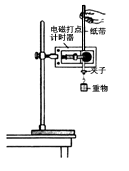问题
实验题
某同学仿照“探究小车速度随时间变化的规律”这一实验,利用如图所示的装置测量重物做自由落体运动的加速度。

(1)对该实验装置及其操作的要求,下列说法正确的是[ ]
A.电磁打点计时器应接6V交流电源
B.打点计时器的两个限位孔应在同一条竖直线上
C.重物最好选用密度较小的材料,如泡沫塑料
D.开始时应使重物靠近打点计时器处并保持静止
E.操作时,应先放开纸带后接通电源
F.为了减小误差,应重复多次实验,在打出的纸带中挑选一条最清晰的
G.为了便于测量,一定要找到打点计时器打下的第一个点,并选取其以后各连续的点作为计数点
(2)下图是某同学在实验中得到的一条较为理想的纸带。把开头几个模糊不清的点去掉,以较清晰的某一个点作为计数点O,随后每打3个点取一个计数点依次标记为点A、B、C 、D。测量出各点间的距离已标在纸带上。求打点计时器打出点2时重物的瞬时速度为 m/s,物体做自由落体运动的加速度的值约为 m/s2。(本题计算结果保留3位有效数字)

答案
(1)ABDF
(2)1.18,9.58
